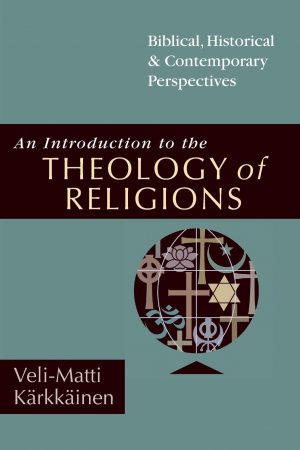The world into which Christianity was born was a religiously plural one, and the world in which Christians now live continues to be so. Although various religions exhibit similarities to one degree or another, they also embody deep differences about the authoritative sources of knowledge and the nature and means of salvation. How should Christian theologians make sense of these similarities and differences?
Answering that question is the task of the theology of religions, which Veli-Matti Kärkkäinen defines in this way:
Theology of religions is that discipline of theological studies which attempts to account theologically for the meaning and value of other religions. Christian theology of religions attempts to think theologically about what it means for Christians to live with people of other faiths and about the relationship of Christianity to other religions (20).
While Kärkkäinen notes that “in principle,” non-Christian religions could develop a theology of religions specific to their own beliefs and practices, as of 2003, little work had been done in this field by those religions. Instead, he writes, “Christian theology of religions is by far the most developed type of theology of religions” (21).
An Introduction to the Theology of Religions thus surveys Christian assessments of other religions in the Bible and across two millennia of church history. It focuses its attention most on the assessments of churches and individual theologians in the twentieth century. Kärkkäinen’s survey unfolds in four parts: (1) biblical perspectives, (2) historical developments, (3) current ecclesiastical approaches, and (4) current interpretations by individual theologians.
The book has three virtues: scope, depth, and typology.
Scope: The book sketches how Christian churches and individual theologians have evaluated the plurality of religions from the biblical period to the present day. This results in a typology, discussed below, that shows how theological arguments and themes recur throughout the centuries.
Depth: The bulk of the book focuses on ecclesiastical statements and individual theologians in the twentieth century, especially the latter. Part Three goes into detail about official documents from the Roman Catholic Church, the worldwide Anglican communion, mainline Protestantism, the Free Churches and the evangelical movement (between which there is a large degree of overlap), and the ecumenical movement, devoting a chapter to each. Part Four considers the writings of 21 individual theologians, again devoting a chapter to each. All the theologians are male, and most are white and Western.
Typology: Kärkkäinen develops a fourfold typology that he hopes to replace the conventional one. The conventional typology characterizes theologies of religions as exclusivist, inclusivist, or pluralist. It was developed by an advocate of pluralism, and advocates of exclusivism especially feel that it is tendentious and denigratory of their position. In its place, Kärkkäinen typifies theologies of religions as ecclesiocentric, Christocentric, theocentric, and realitycentric. He then correlates this fourfold typology with the conventional one, defining each type:
- Ecclesiocentrism. This is the exclusive attitude, according to which religions are not salvific or even necessarily conducive to the search for God, and salvation can be found only in the Christian church, the locus of faith in Christ.
- Christocentrism. This is the inclusive approach, according to which Christ is the Savior but the benefits of his saving work may be found outside the Christian church and Christian religion. However, whoever is saved is only saved through the work of Christ.
- Theocentrism. This is the pluralistic paradigm, according to which Christ is one savior among other savior figures and not an exclusive one. In this view, God alone stands at the center. The various religions, Christianity included, represent many ways leading to God.
- Realitycentrism. This is yet another step from theocentrism, the route taken recently by [John] Hick, among others, according to which the center of religions is not a God or gods but an ultimate reality (however that is named). Some extreme pluralists seem to shift to this orientation, but at this moment the shape and content of this option are still quite vague and undefined (25).
Following the survey of historical developments in Part Two, Kärkkäinen concludes that exclusivism and inclusivism best typify Christian responses throughout history. He writes:
To set the record straight: there have not been (at least to my knowledge) any self-pronounced “pluralists” among Christian theologians before the time of the Enlightenment—even universalists such as Origen attributed the salvation of all to the purposes of the Christian God, the only God. But neither is it the case that a more inclusivist attitude has not existed all through the history (107).
Later, he notes that these positions are prevalent among very different audiences:
Interestingly, numerically there are two giants among ecclesiastical opinions: the Roman Catholic Church’s inclusivism and the quite exclusivistic stance held by evangelical, Pentecostal/Charismatic and (other) independent churches. Pluralism governs the academy, but in the pews these two other views predominate (160).
Notice in these quotations that Kärkkäinen reverts to the conventional typology. This happens throughout the book. Although his fourfold “-centrism” typology has many strengths, it seems that that the conventional typology remains the standard way of describing the various theological positions, both at the time of the book’s publication and today, 17 years later.
Nevertheless, An Introduction to the Theology of Religions is to my knowledge the best overall introduction to this topic, so I recommend it to interested readers.
Book Reviewed
Veli-Matti Kärkkäinen, An Introduction to the Theology of Religions: Biblical, Historical and Contemporary Perspectives(Downers Grove, IL: InterVarsity Press, 2003).
P.S. If you liked my review, please click “Helpful” on my Amazon review page.

